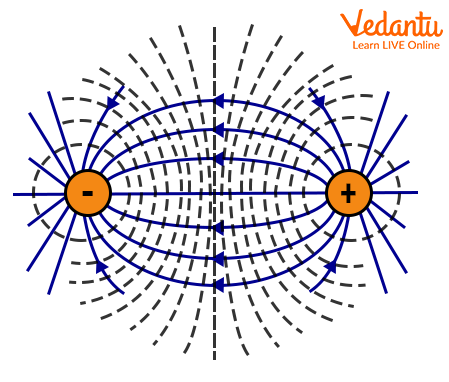




Electric Field Lines: Hypothetical or Real?
The concept of the electric field was first invented by Michael Faraday in the early 19th century. The electric field line is a hypothetical concept used for a better understanding of the direction of electric fields. It can not be seen and is purely an imaginary concept. The electric field depicts the intensity of the electric current in the respective region. The electric field was represented by the electric field line in the diagram. The electric field lines show the direction of current flowing in between the different polarities of the system.
The intensity of the electric current is represented by the length of the electric field lines in the electric field lines representation. The electric field lines are found to be an easier alternative for the demonstration of electric current. In the given article, an attempt has been made to give brief information on electric field lines, properties of electric field lines, electric field direction, and characteristics of electric field lines. This article has been written to give a better understanding of the given topic.
What are Electric Field Lines?
Electric field lines are the imaginary lines that are used to describe the electric field of the system with the help of an electric field line. These electric field lines' directions show the flow of electric charge from positive to negative charge. Those electric field lines which have the same electric field intensity are known as equipotential lines. The electric field lines that originate from the positive charge are called positive lines, and the same for the negative charge is known as negative lines.
Few images depict the electric field lines of point charges and two charges of the different and same polarity.

Image: Electric field lines of a positive and negative charge

Image: Electric field lines of different polarity and same polarity of charge
Characteristics of Electric Field Lines
The electric field lines have various characteristic features which explain the electric field around the system. Some of the characteristic features are given below:
Electric field lines of point charges always originate from the positive charge and terminate at the negative charge. In simple terms, electric field lines always move away from the positive charge and move towards the negative charge. It indicates that the direct flow of charge in the electric field system is from a positive charge to a negative charge.
In one electric field, there is only one direction of flow of electric field lines. Otherwise, if there are two directions of electric field lines, they will probably intersect with each other. Such a type of action by electric field lines is not possible.
An electric field line will be set up on that system where the polarity of the charge is different. When the polarity is different, the direction of the electric field line will move from a positive to a negative charge and an attractive force line between these two charges would set up. There are attractive lines shown between these two charges by the electric field lines.
If the polarity of the charges is the same, the electric field line direction will be like the charges pushing away from each other, and there will be the setup of a repulsive force line between these two charges.
Properties of Electric Field Lines
Depending upon the characteristic features of electric field lines, there are various properties related to the electric field lines listed below:
The electric field lines do not intersect each other at any cost. If they do so, it violates the rules of electric field lines.
The strength of the electric field is maximum where the length of electric field lines is maximum and closer to each other.
The electric field always moves in a perpendicular direction to the charge.
The magnitude of the charge in the electric field system is directly proportional to the number of electric field lines.
The electric field line always originates from the positive charge and terminates on the negative charge.
If there is a single point charge, then the electric field line will originate or terminate at infinity.
The electric field lines are equally spaced and parallel in nature in the case of the uniform electric field.
Conclusion
This article concludes with a brief knowledge regarding the concept of electric field lines along with its characteristics and properties. The article starts with the clarification of the first query, i.e., what are electric field lines. This article explains the action of electric field lines of a point charge and two charges of different polarities and the electric field direction. It also discusses the concept of positive lines and negative lines in the concept of electric field lines. Moreover, it also covers the electric field lines from a diagram point of view for better clarity of this concept.
FAQs on Electric Field Lines Characteristics and Properties for JEE
1. What is the significance of electric field lines?
The significance of electric field lines is to demonstrate the presence of an electric field system around the distribution of electric charges. The arrows of the electric field lines are used to describe the flow of electric charge. The presence of an arrow depicts that the electric field lines emerge from the positive charge to the negative charge. The electric field lines describe the magnitude of electric charge by the length of the electric field lines and show the maximum intensity of electric charge by coming closer to each other.
2. Explain the concept of equipotential lines and equipotential surfaces.
Equipotential lines are those lines that describe the contour of those electric field lines that have the same electric potential. In simple terms, the trajectory of electric field lines has the same voltage. Equipotential lines are always in a perpendicular direction to the electric field. Equipotential lines in a constant electric field are always parallel in nature. According to the three-dimensional perspective, the equipotential lines form the equipotential surfaces. It is a surface that was formed at the same electric potential.
3. What is the weightage of this topic in the JEE exam?
The weightage of the current topic, titled 'Electric Field Lines,' is 6%. The chapter on electric current was found to be the most important topic for the JEE Main as well as JEE Advanced. Nearly 2-3 questions can be expected in the given competitive examination of JEE. For better performance in this section, it is required to keep a check on every topic and practise a maximum number of questions. Hence, it is necessary to give importance to this chapter from JEE's point of view.
























